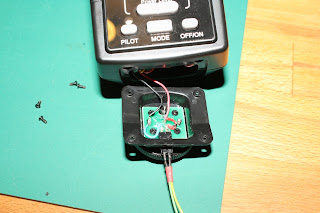As part of a larger project today I needed to sync my flashgun with an Arduino. Since I don't have any hotshoe connectors or anything like that, I decided to add a sync port to the flash itself.
Now I've read more than a few posts about people adding PC sync ports to their flashes (especially the YN-46x series), but since I don't own a single PC sync cable or any kind of connectors, I decided to go with a more breadboard/Arduino friendly option.
This hack doesn't impare the function of the flashgun in any way - it still functions as a normal flashgun, via the hotshoe or optical slave. It's just got an extra connector.
 What you see above is the finished product - the addition is just a tiny 2-pin PCB header, like the ones you get on the Arduino itself. It's cheap, tiny and versatile, and it fits right into the base of the unit.
What you see above is the finished product - the addition is just a tiny 2-pin PCB header, like the ones you get on the Arduino itself. It's cheap, tiny and versatile, and it fits right into the base of the unit.
And that's the inside of the base. I've simply drilled a few 3mm holes in the side, cleaned up the hole with a knife, and slid the connector in.
The connector (seen above right) is 2.56mm pitch female PCB header (the big black strip). It comes in rows of 20 and needs to be cut to size. You can do this with a knife (carefully, and on a cutting mat!). It's pretty cheap on eBay, which is good, because I go through stacks of it!
Once I had the hole drilled and the connector slid in place, I soldered from the terminals on the new connector to the terminals on the existing connector. Finally, I covered the whole thing in Uhu glue to keep it secure (I forgot that the centre pin moves up and down - DON'T PUT GLUE ON THE CENTER PIN)
What I have now is a flashgun which can be hooked up to a breadboard for use with an Arduino. To trigger the flash, simply join the two leads together (either physically, with a physical switch, or with some kind of electronic switch)
Check out my next blog post (still to be written) to see what you can achieve with a Canon 7d, flashgun, Arduino, laser, and things which will break or pop or explode
Now I've read more than a few posts about people adding PC sync ports to their flashes (especially the YN-46x series), but since I don't own a single PC sync cable or any kind of connectors, I decided to go with a more breadboard/Arduino friendly option.
This hack doesn't impare the function of the flashgun in any way - it still functions as a normal flashgun, via the hotshoe or optical slave. It's just got an extra connector.
 What you see above is the finished product - the addition is just a tiny 2-pin PCB header, like the ones you get on the Arduino itself. It's cheap, tiny and versatile, and it fits right into the base of the unit.
What you see above is the finished product - the addition is just a tiny 2-pin PCB header, like the ones you get on the Arduino itself. It's cheap, tiny and versatile, and it fits right into the base of the unit.And that's the inside of the base. I've simply drilled a few 3mm holes in the side, cleaned up the hole with a knife, and slid the connector in.
The connector (seen above right) is 2.56mm pitch female PCB header (the big black strip). It comes in rows of 20 and needs to be cut to size. You can do this with a knife (carefully, and on a cutting mat!). It's pretty cheap on eBay, which is good, because I go through stacks of it!
Once I had the hole drilled and the connector slid in place, I soldered from the terminals on the new connector to the terminals on the existing connector. Finally, I covered the whole thing in Uhu glue to keep it secure (I forgot that the centre pin moves up and down - DON'T PUT GLUE ON THE CENTER PIN)
What I have now is a flashgun which can be hooked up to a breadboard for use with an Arduino. To trigger the flash, simply join the two leads together (either physically, with a physical switch, or with some kind of electronic switch)
Check out my next blog post (still to be written) to see what you can achieve with a Canon 7d, flashgun, Arduino, laser, and things which will break or pop or explode







No comments:
Post a Comment